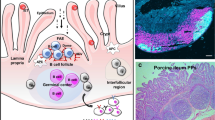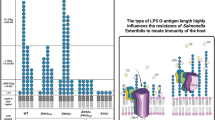Abstract
An animal model resembling the human disease caused byCampylobacter jejuni has been developed. Characteristic illness followed intragastric challenge of neonatal mice with strains ofC. jejuni enhanced for virulence by serial intraperitoneal passage in weanling mice of organisms suspended in either mucin or iron dextran. Such passage lowered the LD50 in weanlings from 2×1011 colony-forming units (CFU) to 2×105 CFU per mouse. Neonatal mice chellenged by intragastric intubation with 2×109 CFU of the virulence-enhanced organisms suspended in mucin or iron dextran showed signs of infection by day 5, including severe diarrhea, increased musus discharge occasionally with blood, and reduced weight gain. Diarrhea contionued for eight days, after which most animals recovered. This mouse infection model provides a means for assessing the determinants of virulence among strains ofC. jejuni.
Similar content being viewed by others
Literature Cited
Becroft, D. M. O., Dix, M. R., Farmer, K. 1977. Intramuscular iron dextran and susceptibility of neonates to bacterial infections. Archives of Diseases in Children52:778–781.
Blaser, M. J., Berkowitz, I. D., Laforce, F. M., Cravens, J., Reller, L. B., Wang, W. L. 1979. Campylobacter enteritis: Clinical and epidemiologic features. Annals of Internal Medicine91:179–185.
Blaser, M. J., Duncan, D. J., Warren, G., Wang, W. L. L. 1983. ExperimentalCampylobacter infection in adult mice. Infection and Immunity39:908–916.
Blaser, M. J., Wells, J. G., Feldman, R. A., Pollard, R. A., Allen, J. R. Collaborative Diarrheal Disease Study Group. 1983. Campylobacter in United States. Annals of Internal Medicine98:360–365.
Butzler, J. P., Skirrow, M. B. 1979. Campylobacter enteritis. Clinical Gastroenterology8:737–765.
Caldwell, M. B., Walker, R. I., Stewart, S. D., Rogers, J. E. 1983. Simple adult rabbit model forCampylobacter jejuni entiritis. Infection and Immunity42:1176–1182.
Calver, G. A., Henney, C. P., Lavergne, G. 1976. Iron as a replacement for mucin in the establishment of meningococcal infection in mice. Canadian Journal of Microbiology22:832–838.
Drake, A. A., Gilchrist, M. J. R., Washington, J. A., Huizengia, K. A., Vanscoy, R. E. 1981. Diarrhea due toCampylobacter fetus s.s. jejuni. Mayo Clinic Proceedings56:414–423.
Eubanks, E. R., Guentzel, M. N., Berry, L. J. 1976. Virulence factors involved in the intraperitoneal infection of adult mice withVibrio cholerae. Infection and Immunity13:457–463.
Field, L. H., Berry, J. J. 1981. Intestinal colonization of neonatal animals byCampylobacter fetus s.s. jejuni. Infection and Immunity33:884–892.
Firehammer, B. D., Myers, L. L. 1981. ExperimentalCampylobacter fetus ssp.jejuni infection in valves. American Journal of Veterinary Research42:918–922.
Fitzgeorge, R., Bakerville, A. 1981. ExperimentalCampylobacter jejuni infection in Rhesus monkeys, pp. 180–181. In: Newell, D. (ed.), Campylobacter: epidemiology, pathogenesis and biochemistry. Lancaster, UK: MTP.
Hebert, G. A., Hollis, D. G., Weaver, R. E., Lambert, M. A., Blaser, M. J., Moss, C. W. 1982. Thirty years of Campylobacters: biochemical characteristics and a biotyping proposal forC. jejuni. Journal of Clinical Microbiology15:1065–1073.
Hoffman, P. S., George, H. A., Krieg, N. R., Smibert, R. M. 1979. Studies of the micro-aerophilic nature ofCampylobacter fetus subsp.jejuni. II. Role of exogenous superoxide anions and hydrogen peroxide. Canadian Journal of Microbiology25:8–16.
Holbein, B. E., Jericho, K. W. F., Likes, G. C. 1979.Neisseria meningitidis infection in mice: influence of iron, variation in virulence among strains and pathology. Infection and Immunity24:545–551.
Kochan, I., Wasynezuk, J., McCabe, M. A. 1978. Effects of injected iron and siderophores on infections in normal and immune mice. Infection and Immunity22:560–567.
Kochan, I., Golden, C. A., Bukovic, J. A. 1969. Mechanisms of tuberculosis in mammalian serum. II. Induction of serum tuberculosis in guinea pigs. Journal of Bacteriology600:64–70.
Manninen, K. I., Prescott, J. F., Dohoo, I. R. 1982. Pathologenicity ofCampylobacter jejuni isolates from animals and humans. Infection and Immunity38: 46–52.
Miles, A. A., Misra, S. 1938. The estimation of the bacteriocidal power of the blood. Journal of Hygiene38:732–749.
Prescott, J. F., Barker, I. K., Manninem, K. I., Miniats, O. P. 1980.Campylobacter jejuni colitis in gnotobiotic dogs. Canadian Journal of Comprehensive Medicine45:377–383.
Reed, L. J., Muench, H. 1938. A simple method of estimating fifty percent end points. American Journal of Hygiene27:493–497.
Ruiz-Palacios, G. M., Escamilla, E., Torres, N. 1981. Experimental Campylobacter diarrhea in chickens. Infection and Immunity34:250–255
Skirrow, M. B. 1977. Campylobacter enteritis: a “new” disease. British Medical Journal1:9–11.
Smith, R. E., Carey, A. M., Damare, J. M., Hetrick, F. M., Johnston, R. W., Lee, W. H. 1981. Evaluation of iron dextran and micin for enhancement of the virulence ofYersinia enterocolitica serotype 0:3 in mice. Infection and Immunity34:550–560.
Suveges, I., Glavits, R. 1976. Piglet losses due to parenteral application of iron dextran preparation. Acta Veterinary Academy of Science Hungary26:257–262.
Weinberg, E. D. 1978. Iron and infecton. Microbiology Reviews42:45–66.
Weinberg, E. D. 1974. Iron and susceptibility to infectious disease. Science184:952–956.
Wright, A. C., Simpson, L. M., Oliver, J. D. 1981. Role of iron in the pathogenesis ofVibrio vulnificus infections. Infection and Immunity34:503–507.
Author information
Authors and Affiliations
Rights and permissions
About this article
Cite this article
Kazmi, S.U., Roberson, B.S. & Stern, N.J. Animal-passed, virulence-enhancedCampylobacter jejuni causes enteritis in neonatal mice. Current Microbiology 11, 159–164 (1984). https://doi.org/10.1007/BF01567342
Issue Date:
DOI: https://doi.org/10.1007/BF01567342




